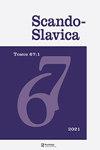Символизм Андрея Белого в эпоху джаза – контрапункты двух философий (на примере «Котика Летаева»)
IF 0.2
0 HUMANITIES, MULTIDISCIPLINARY
引用次数: 0
Abstract
ABSTRACT The connection between jazz philosophy, pre-jazz genres and Belyj’s creational method is analyzed in this paper through cultural-historical, comparative and mythopoetic methods. The tunes of jazz predecessors (spirituals, blues, ragtime, working songs) had started to spread in Russian since the beginning of the 20th century. Andrej Belyj also could have become acquainted with jazz culture in Europe during his frequent journeys. The most prominent features of jazz are difficult rhythms originated in African drums playing style, the influence of European musical harmony, but at the same time dedication to dissonances, accents on weak beats, “blue mood,” “call-and-response pattern,” scat, falsetto break from working songs and many others. The novel Kotik Letaev could be called the most jazz-inspiring work of the author. Despite the fact that this novel has been created at the dawn of “jazz era,” there are a lot of features that connect this work to jazz philosophy. Belyj sensed the mood of his time, the jazz pulsation of the century. Returning to the ancient African drums rhythm in jazz has its reflection in Belyj’s novel through the resurrection of the myth, remembering the “inner form” of words which was used by the first speaking man on the Earth, rebirth of the word through the child speech. Kotik Letaev is rhythmically complex text decorated with alliteration – the scat analogy. Every character in Kotik Letaev has their own melody and musical voice. “Blue mood” is also a prominent feature in this novel: fear and anxiety (“blue tonality”) govern the text. It could be attributed to Kotik Letaev’s feeling of dread after the escape from the chaotic pre-existence and his attempts to find his place in new cosmos. The main elements of the novel’s inner structure are dissonance and ambivalence. Improvisation in word, sound and symbol creation is used in the novel, which also reminds us about jazz intention to overcome any previous boundaries in music in order to express inexpressible.安德烈·贝利在爵士乐时代的象征意义——两种哲学的对位(以“科蒂卡·莱塔耶夫”为例)
本文通过文化史学、比较学和神话学的方法分析了爵士哲学、前爵士流派与贝雷伊创作方法之间的联系。爵士前辈的曲调(灵歌、布鲁斯、拉格泰姆、劳动歌曲)自20世纪初开始在俄罗斯传播。在他频繁的旅行中,安德烈·贝雷也可能对欧洲的爵士文化有所了解。爵士乐最突出的特点是源于非洲鼓演奏风格的困难节奏,受到欧洲音乐和声的影响,但同时也致力于不和谐、弱节拍上的重音、“蓝色情绪”、“呼唤与回应模式”、scat、工作歌曲中的假声中断等等。小说《科蒂克·列塔耶夫》可以说是作者最鼓舞人心的作品。尽管这部小说是在“爵士时代”的黎明创作的,但它有很多特征将它与爵士哲学联系起来。Belyj感受到了他那个时代的情绪,感受到了本世纪爵士乐的脉动。回到古代非洲的鼓声节奏,爵士乐在Belyj的小说中通过神话的复活,记住地球上第一个说话的人使用的“内在形式”,通过孩子的言语来实现单词的重生。《科蒂克·莱塔耶夫》是一部节奏复杂的文本,用头韵来修饰——即猫的比喻。《Kotik Letaev》中的每个角色都有自己的旋律和音乐声音。“蓝色情绪”也是这部小说的一个突出特点:恐惧和焦虑(“蓝色调性”)支配着文本。这可以归因于Kotik Letaev逃离混乱的前世后的恐惧感,以及他试图在新宇宙中找到自己的位置。小说内部结构的主要元素是不和谐和矛盾。小说在文字、声音和符号的创作上都采用了即兴创作,这也提醒我们爵士乐的意图是为了表达不可表达的东西而超越音乐中以往的任何界限。
本文章由计算机程序翻译,如有差异,请以英文原文为准。
求助全文
约1分钟内获得全文
求助全文

 求助内容:
求助内容: 应助结果提醒方式:
应助结果提醒方式:


